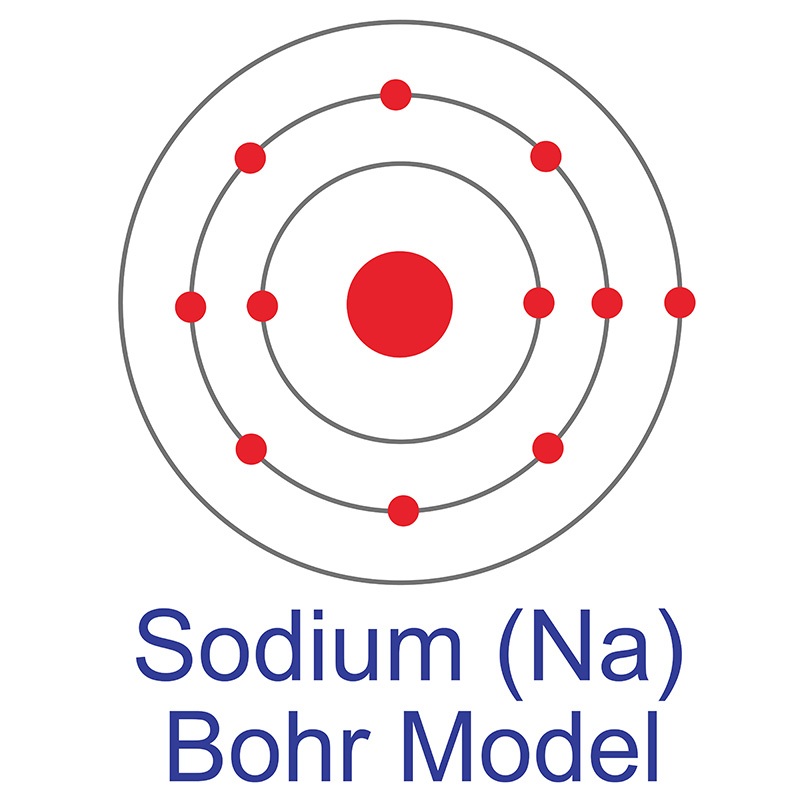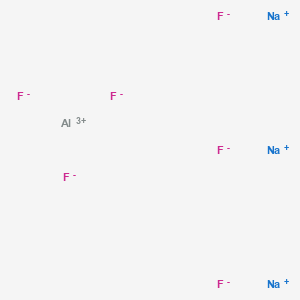SECTION 1. IDENTIFICATION
Product Name: Sodium Hexafluoroaluminate
Product Number: All applicable American Elements product codes, e.g. NA-6FALO-02
, NA-6FALO-03
, NA-6FALO-04
, NA-6FALO-05
CAS #: 13775-53-6
Relevant identified uses of the substance: Scientific research and development
Supplier details:
American Elements
10884 Weyburn Ave.
Los Angeles, CA 90024
Tel: +1 310-208-0551
Fax: +1 310-208-0351
Emergency telephone number:
Domestic, North America: +1 800-424-9300
International: +1 703-527-3887
SECTION 2. HAZARDS IDENTIFICATION
Classification of the substance or mixture
GHS Classification in accordance with 29 CFR 1910 (OSHA HCS)
Acute toxicity, Inhalation(Category 4), H332
Effects on or via lactation, H362
Specific target organ toxicity -repeated exposure(Category 1), H372
Acute aquatic toxicity(Category 2), H401
Chronic aquatic toxicity(Category 2), H411
GHS Label elements, including precautionary statements
Pictogram
Signal word
Danger
Hazard statement(s)
H332
Harmful if inhaled.
H362
May cause harm to breast-fed children.
H372
Causes damage to organs through prolonged or repeated exposure.
H411
Toxic to aquatic life with long lasting effects.
Precautionary statement(s)
P201
Obtain special instructions before use.
P260
Do not breathe dust/ fume/ gas/ mist/ Vapors/ spray.
P263
Avoid contact during pregnancy/ while nursing.
P264
Wash skin thoroughly after handling.
P270
Do not eat, drink or smoke when using this product.
P271
Use only outdoors or in a well-ventilated area.
P273
Avoid release to the environment.
P304 + P340 + P312
IF INHALED: Remove victim to fresh air and keep at rest in a position comfortable for breathing. Call a POISON CENTER or doctor/ physician if you feel unwell.
P308 + P313
IF exposed or concerned: Get medical advice/ attention.
P391
Collect spillage.
P501
Dispose of contents/ container to an approved waste disposal plant.
Hazards not otherwise classified (HNOC) or not covered by GHS-none
SECTION 3. COMPOSITION/INFORMATION ON INGREDIENTS
Substances
Synonyms: Cryolite, synthetic
Formula: AlF6Na3
Molecular weight: 209.94 g/mol
CAS-No.: 13775-53-6
EC-No.: 237-410-6
Index-No.: 009-016-00-2
SECTION 4. FIRST AID MEASURES
Description of first aid measures
General advice
Consult a physician. Show this safety data sheet to the doctor in attendance.
Move out of dangerous area.
If inhaled
If breathed in, move person into fresh air. If not breathing, give artificial respiration. Consult a physician.
In case of skin contact
Wash off with soap and plenty of water. Take victim immediately to hospital. Consult a physician.
In case of eye contact
Flush eyes with water as a precaution.
If swallowed
Never give anything by mouth to an unconscious person. Rinse mouth with water. Consult a physician.
Most important symptoms and effects, both acute and delayed
The most important known symptoms and effects are described in the labelling (see section 2) and/or in section 11
Indication of any immediate medical attention and special treatment needed
No data available
SECTION 5. FIREFIGHTING MEASURES
Extinguishing media
Suitable extinguishing media
Use water spray, alcohol-resistant foam, dry chemical or carbon dioxide.
Special hazards arising from the substance or mixture
Hydrogen fluoride, Sodium oxides, Aluminum oxide
Advice for firefighters
Wear self-contained breathing apparatus for firefighting if necessary.
Further information
No data available
SECTION 6. ACCIDENTAL RELEASE MEASURES
Personal precautions, protective equipment and emergency procedures
Use personal protective equipment. Avoid dust formation. Avoid breathing Vapors, mist or gas. Ensure adequate ventilation. Evacuate personnel to safe areas. Avoid breathing dust.
For personal protection see section 8.
Environmental precautions
Prevent further leakage or spillage if safe to do so. Do not let product enter drains. Discharge into the environment must be avoided.
Methods and materials for containment and cleaning up
Pick up and arrange disposal without creating dust. Sweep up and shovel. Keep in suitable, closed containers for disposal.
Reference to other sections
For disposal see section 13.
SECTION 7. HANDLING AND STORAGE
Precautions for safe handling
Avoid contact with skin and eyes. Avoid formation of dust and aerosols.
Further processing of solid materials may result in the formation of combustible dusts. The potential for combustible dust formation should be taken into consideration before additional processing occurs.
Provide appropriate exhaust ventilation at places where dust is formed.
For precautions see section 2.
Conditions for safe storage, including any incompatibilities
Keep container tightly closed in a dry and well-ventilated place.
Keep in a dry place.
Storage class (TRGS 510): Non-combustible, acute toxic Cat.3 / toxic hazardous materials or hazardous materials causing chronic effects
Specific end use(s)
Apart from the uses mentioned in section 1 no other specific uses are stipulated.
SECTION 8. EXPOSURE CONTROLS/PERSONAL PROTECTION
Exposure controls
Appropriate engineering controls
Handle in accordance with good industrial hygiene and safety practice. Wash hands before breaks and at the end of workday.
Personal protective equipment
Eye/face protection
Face shield and safety glasses Use equipment for eye protection tested and approved under appropriate government standards such as NIOSH (US) or EN 166(EU).
Skin protection
Handle with gloves. Gloves must be inspected prior to use. Use proper glove removal
technique (without touching glove's outer surface) to avoid skin contact with this product. Dispose of contaminated gloves after use in accordance with applicable laws and good laboratory practices. Wash and dry hands.
Body Protection
Complete suit protecting against chemicals, The type of protective equipment must be selected according to the concentration and amount of the dangerous substance at the specific workplace.
Respiratory protection
Where risk assessment shows air-purifying respirators are appropriate use a full-face particle respirator type N100 (US) or type P3 (EN 143) respirator cartridges as a backup to engineering controls. If the respirator is the sole means of protection, use a full-face supplied air respirator. Use respirators and components tested and approved under appropriate government standards such as NIOSH (US) or CEN (EU).
Control of environmental exposure
Prevent further leakage or spillage if safe to do so. Do not let product enter drains. Discharge into the environment must be avoided.
SECTION 9. PHYSICAL AND CHEMICAL PROPERTIES
Information on basic physical and chemical properties
Appearance
Form: powder
Odor
No data available
Odor Threshold
No data available
pH
No data available
Melting point/freezing point
No data available
Initial boiling point and boiling range
No data available
Flash point
N/A
Evaporation rate
No data available
Flammability (solid, gas)
No data available
Upper/lower flammability or explosive limits
No data available
Vapor pressure
No data available
Vapor density
No data available
Relative density
2.9 g/mL at 25 °C (77 °F)
Water solubility
0.602 g/l at 20 °C (68 °F)
Partition coefficient: n-octanol/water
No data available
Auto-ignition temperature
No data available
Decomposition temperature
No data available
Viscosity
No data available
Explosive properties
No data available
Oxidizing properties
No data available
Other safety information
No data available
SECTION 10. STABILITY AND REACTIVITY
Reactivity
No data available
Chemical stability
Stable under recommended storage conditions.
Possibility of hazardous reactions
No data available
Conditions to avoid
No data available
Incompatible materials
Strong bases
Hazardous decomposition products
Other decomposition products-No data available
In the event of fire: see section 5
SECTION 11. TOXICOLOGICAL INFORMATION
Information on toxicological effects
Acute toxicity
LD50 Oral-Rat-> 5,000 mg/kg
Remarks: Gastrointestinal:Changes in structure or function of salivary glands. Skin and Appendages: Other: Hair.
Inhalation: No data available
Dermal: No data available
No data available
Skin corrosion/irritation
Skin-Rat
Result: No skin irritation
Serious eye damage/eye irritation
Eyes-Rat
Result: No eye irritation
Respiratory or skin sensitisation
Maximisation Test (GPMT)-Guinea pig
Result: Does not cause skin sensitisation.(OECD Test Guideline 406)
Germ cell mutagenicity
No data available
Carcinogenicity
IARC:
No component of this product present at levels greater than or equal to 0.1% is identified as
probable, possible or confirmed human carcinogen by IARC.
NTP:
No component of this product present at levels greater than or equal to 0.1% is identified as a
known or anticipated carcinogen by NTP.
OSHA:
No component of this product present at levels greater than or equal to 0.1% is identified as a
carcinogen or potential carcinogen by OSHA.
Reproductive toxicity
No data available
Effects on or via lactation
Specific target organ toxicity -single exposure
No data available
Specific target organ toxicity -repeated exposure
Causes damage to organs through prolonged or repeated exposure.
Aspiration hazard
No data available
Additional Information
RTECS: BD0075000
To the best of our knowledge, the chemical, physical, and toxicological properties have not been thoroughly investigated.
SECTION 12. ECOLOGICAL INFORMATION
Toxicity
Toxicity to fish
LC50-Danio rerio (zebra fish)-99 mg/l-96 h(OECD Test Guideline 203)
Toxicity to daphnia and other aquatic invertebrates
EC50-Daphnia pulex (Water flea)-5 mg/l-48 h
EC50-Daphnia magna (Water flea)-156 mg/l-48 h(OECD Test Guideline 202)
Toxicity to algae
Growth inhibition NOEC-Selenastrum capricornutum (green algae)-1 mg/l-72 h
(OECD Test Guideline 201)
Persistence and degradability
Biodegradability
Result: -Not readily biodegradable.
Bioaccumulative potential
No data available
Mobility in soil
No data available
Results of PBT and vPvB assessment
PBT/vPvB assessment not available as chemical safety assessment not required/not conducted
Other adverse effects
An environmental hazard cannot be excluded in the event of unprofessional handling or disposal.
Toxic to aquatic life with long lasting effects.
SECTION 13. DISPOSAL CONSIDERATIONS
Waste treatment methods
Product
Offer surplus and non-recyclable solutions to a licensed disposal company.
Contact a licensed professional waste disposal service to dispose of this material.
Contaminated packaging
Dispose of as unused product.
SECTION 14. TRANSPORT INFORMATION
DOT (US)
Not dangerous goods
IMDG
UN number: 3077
Class: 9
Packing group: III
EMS-No: F-A, S-F
Proper shipping name: ENVIRONMENTALLY HAZARDOUS SUBSTANCE, SOLID, N.O.S.
(Trisodium hexafluoroaluminate)
Marine pollutant: yes
IATA
UN number: 3077
Class: 9
Packing group: III
Proper shipping name: Environmentally hazardous substance, solid, n.o.s.(Trisodium hexafluoroaluminate)
Further information
EHS-Mark required (ADR 2.2.9.1.10, IMDG code 2.10.3) for single packagings and combination packagings containing inner packagings with Dangerous Goods > 5L for liquids or > 5kg for solids.
SECTION 15. REGULATORY INFORMATION
SARA 302 Components
No chemicals in this material are subject to the reporting requirements of SARA Title III, Section 302.
SARA 313 Components
This material does not contain any chemical components with known CAS numbers that exceed the threshold (De Minimis) reporting levels established by SARA Title III, Section 313.
SARA 311/312 Hazards
Acute Health Hazard
Massachusetts Right To Know Components
No components are subject to the Massachusetts Right to Know Act.
Pennsylvania Right To Know Components
Trisodium hexafluoroaluminate
CAS-No.
13775-53-6
Revision Date
2008-06-01
New Jersey Right To Know Components
Trisodium hexafluoroaluminate
CAS-No.
13775-53-6
Revision Date
2008-06-01
California Prop. 65 Components
This product does not contain any chemicals known to State of California to cause cancer, birth defects, or any other reproductive harm.
SECTION 16. OTHER INFORMATION
Safety Data Sheet according to Regulation (EC) No. 1907/2006 (REACH). The above information is believed to be correct but does not purport to be all inclusive and shall be used only as a guide. The information in this document is based on the present state of our knowledge and is applicable to the product with regard to appropriate safety precautions. It does not represent any guarantee of the properties of the product. American Elements shall not be held liable for any damage resulting from handling or from contact with the above product. See reverse side of invoice or packing slip for additional terms and conditions of sale. COPYRIGHT 1997-2022 AMERICAN ELEMENTS. LICENSED GRANTED TO MAKE UNLIMITED PAPER COPIES FOR INTERNAL USE ONLY.

 See more Sodium products.
See more Sodium products. Aluminum's name is derived from alumina, the mineral from which Sir Humphrey Davy attempted to refine it from in 1812. Aluminum was first predicted by Antoine Lavoisier 1787 and first isolated by Hans Christian Øersted in 1825. Aluminum is a silvery gray metal that possesses many desirable characteristics. It is light, nonmagnetic and non-sparking. It stands second among
Aluminum's name is derived from alumina, the mineral from which Sir Humphrey Davy attempted to refine it from in 1812. Aluminum was first predicted by Antoine Lavoisier 1787 and first isolated by Hans Christian Øersted in 1825. Aluminum is a silvery gray metal that possesses many desirable characteristics. It is light, nonmagnetic and non-sparking. It stands second among  Although it has only 60% of the electrical conductivity of
Although it has only 60% of the electrical conductivity of 
